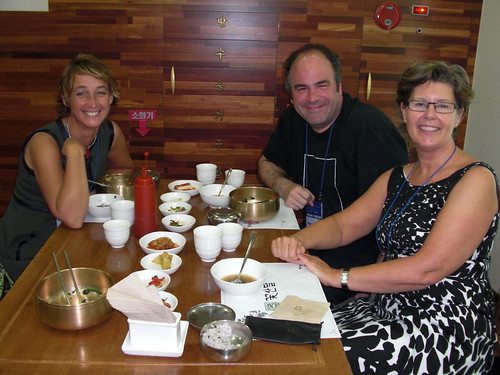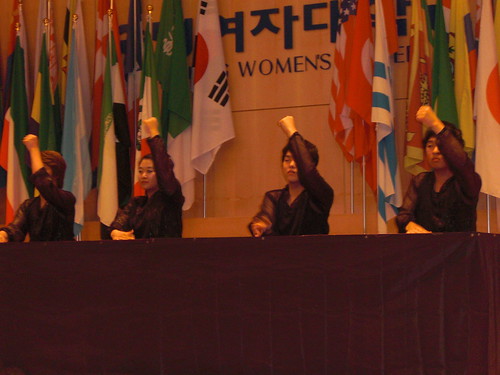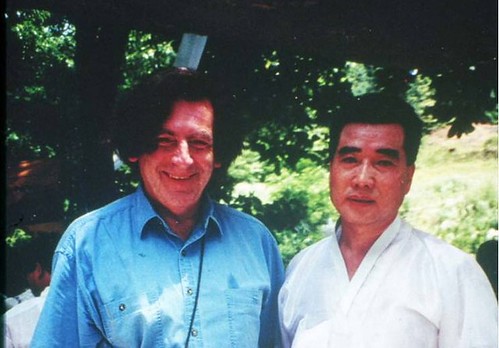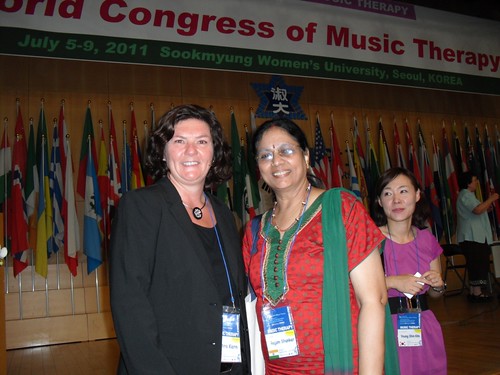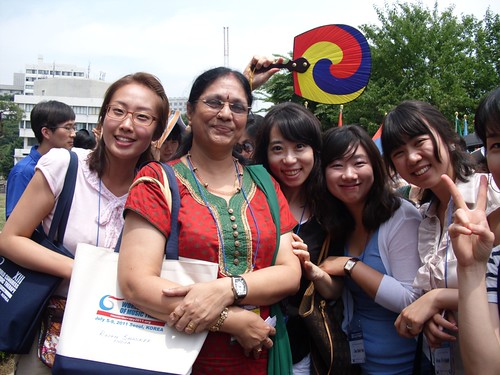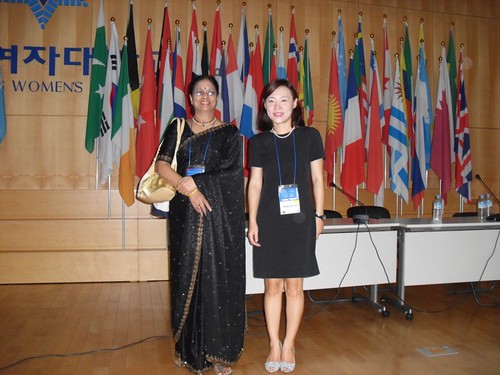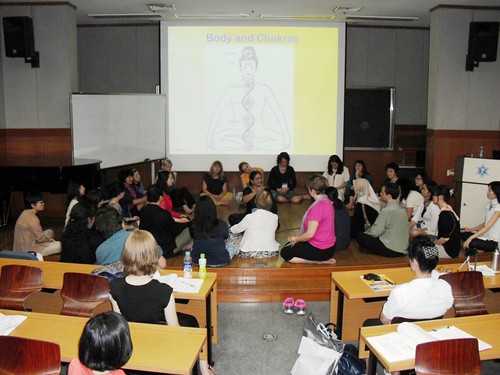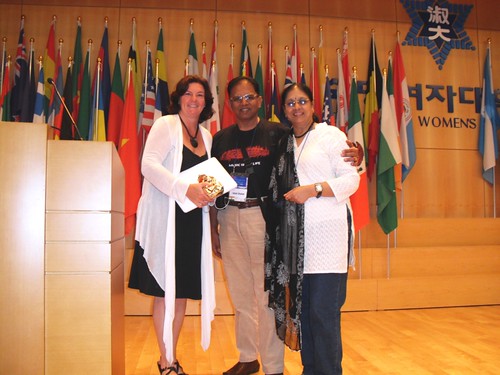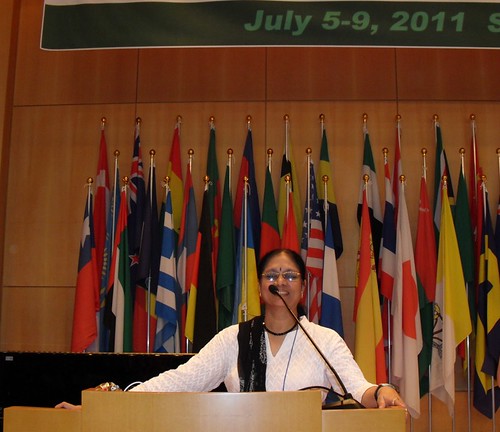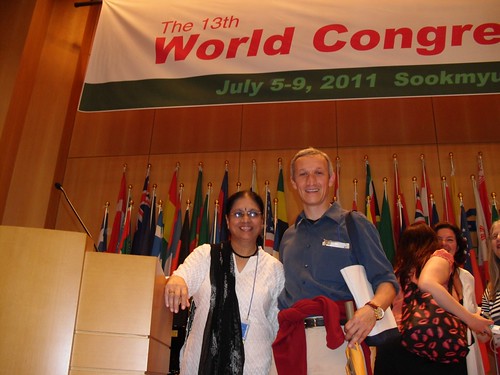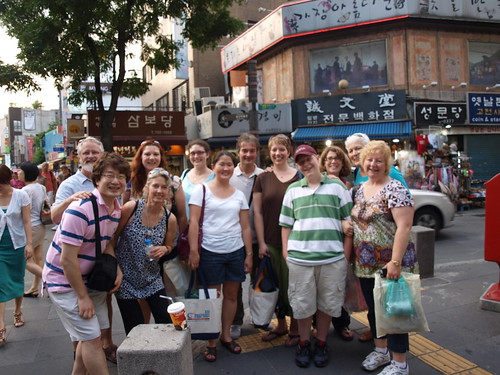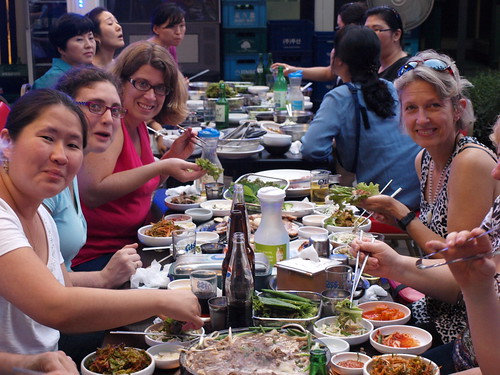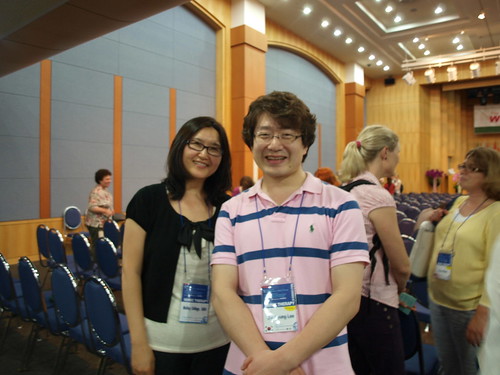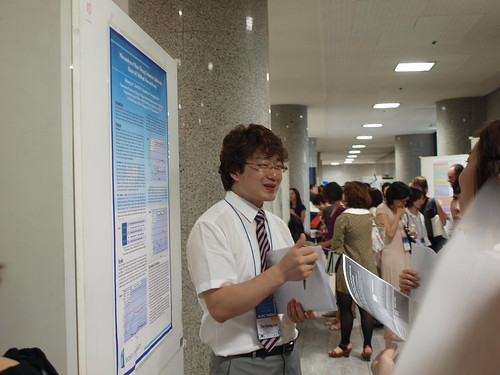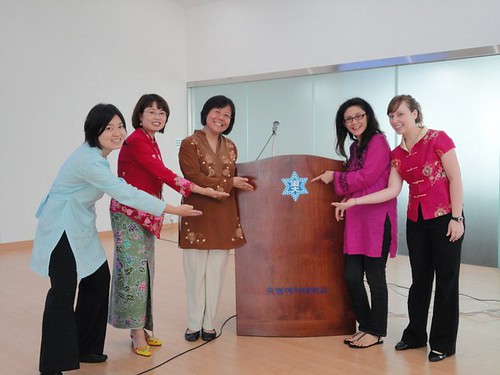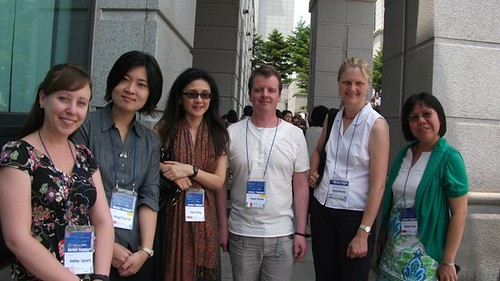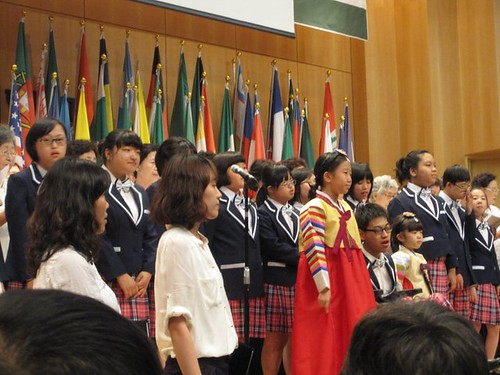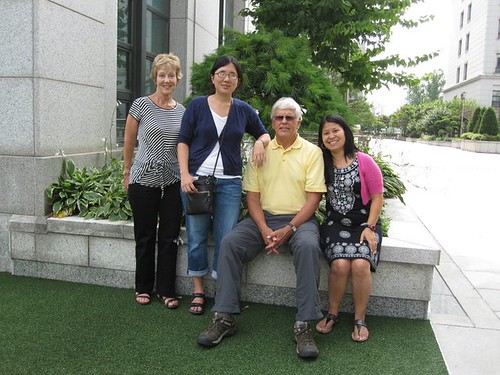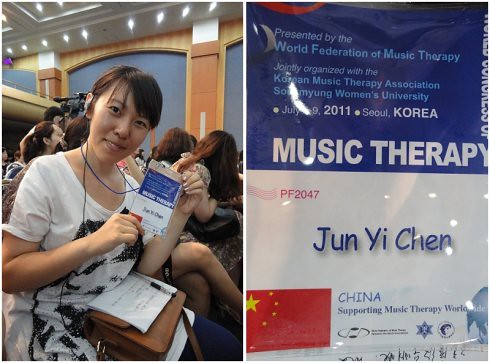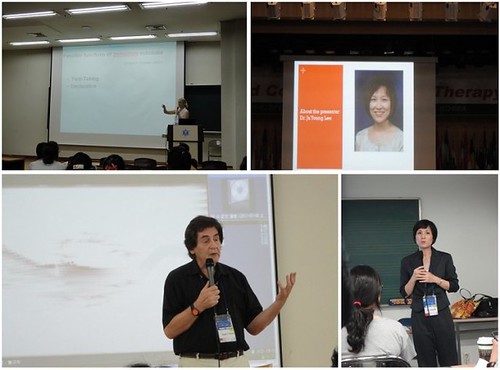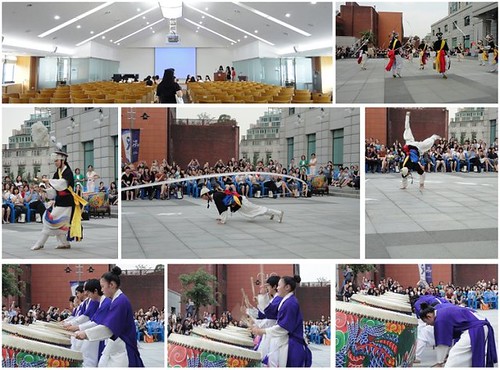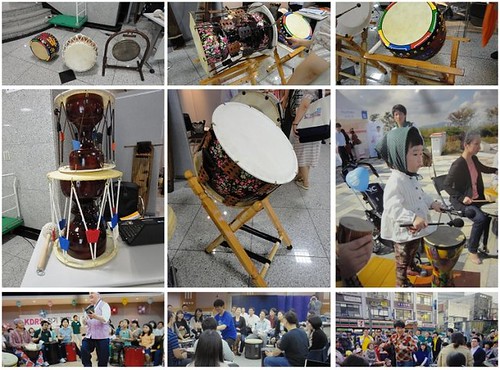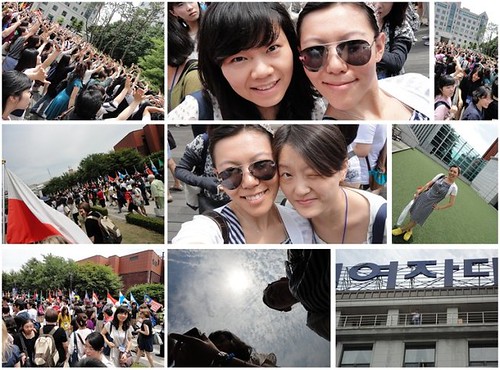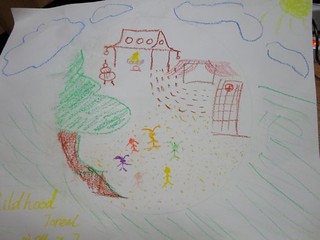[Original Voices: World Congresses of Music Therapy]
Memories from the 13th World Congress of Music Therapy
Edited by Seung-A Kim
Gro Trondalen, Professor at the Norwegian Academy of Music, Oslo, Norway
Memorable Days in Seoul,
Seoul: a city with a history stretching back for more than 2 000 years. Seoul: the largest metropolitan center of South Korea, situated on the Han River. Seoul: a city that hosts palaces and places with outstanding examples of Far Eastern palace architecture and garden design. Seoul: the city of the 13th WCMT, creating so many memorable days. I would like to draw attention to some memories from the outside—and the inside of the congress venue.
#1 Outside the Congress: Be our Guest
One vital memory is the Seoul metropolitan subways. The city’s comprehensive subway network interconnects every district of the city and the surrounding areas. Seoul has the second busiest subway in the world, commuting more than 8 million passengers every day. I wanted to experience this subway during Seoul’s rush hour. As a tall Norwegian woman, I was standing in the middle of the coach, a good 20 centimeters taller than most of the Koreans surrounding me. During rush hour, every single space was occupied in "my coach" except for one seat next to an older man. Nobody seemed to sit down on the open seat. Neither did I. At one point I realized many people were looking at me. The older man gave me a smile, nodded towards the seat, and obviously invited me to sit next to him. I looked around and many people were nodding, and smiling. I started to smile myself, realizing what they were trying to tell me: "be our guest and have a rest on the free seat." I sat down, looked at the fully packed subway — I was very grateful for the way the people on the subway treated a tall and tired female foreigner like me.
#2 Inside the Congress: A Sense of Belonging
Other outstanding memories are those connected to the music and the spectacular cultural events. I enjoyed every minute of the dancing and singing from women in their national costumes, as much as I enjoyed watching the women (and men) in black: drumming their way through time and space. Both old and new friends from all over the world shared and discussed the events, as well as the scholarly content of the congress, during meals. A sharing of experiences and a mutual interest in music therapy in a broad sense created a wonderful sense of belonging throughout the congress. The spotlight sessions were organized in groups and related to varied topics at the conference. Whenever I was speaking in one of the spotlight sessions, I therefore felt I belonged to a joint community of researchers and clinical practitioners: we all were there, sharing our love and commitment to the field of music therapy.
Alan Turry, DA, MT-BC, LCAT, NRMT, Managing Director, Nordoff-Robbins Center for Music Therapy
Enthusiasm. That is the first word that comes to my mind when I think about the Congress in Seoul: The enthusiasm of the participants, the presenters, the performers. There seemed to be an unspoken excitement in the air. I am sure it was my excitement to be at such a gathering. I was excited to be a part of the program and felt a sense of support and interest when sharing clinical work. I was very gratified to see the development of the Nordoff-Robbins approach in Korea. It was clear that my Korean Nordoff-Robbins colleagues had done much to generate interest in the approach. Two vivid scenes I recall: conference attendees perched on windowsills outside of lecture rooms so that they could hear presentations, and watching the photographer move precariously from one position to another in order to get the perfect picture of all of us gathered together outside. I was impressed with the poise of the organizers who were faced with the gargantuan task of running the event.
The audience responses were extremely enthusiastic particularly when it came to hands on music making experiences. Even during the keynote when I was playing live music, I sensed that people appreciated the chance to engage and interact with live music. In terms of teaching methods—when it was clear that it was safe to take risks without being judged as wrong, when participants recognized they could explore and make mistakes, and that participants did not have to 'perform' and play perfectly—they were able to tap into their natural musicality more freely and enjoyed doing so. It was wonderful to meet new friends and spend time with old friends in a special place. I loved the Kimchee and the barbecued beef—great food!
Joseph Moreno, Professor Emeritus, Maryville University-Saint Louis, Missouri
I have been fortunate to have traveled widely, both through my professional work and other means, and these travels have enabled me to encounter and explore indigenous music and healing traditions in many countries and cultures .Some notable examples have included the Afro-Brazilian candomble, the ayhuasca and music ritual healing in the Peruvian Amazon, the Hindu thaipussam in Malaysia, the trance inducing qualli music in Pakistan, the music and firewalking anastenaria in Greece, Navajo healing in the United States, the tromba healing practices in Madagascar, and other music healing practices in Bali, Kenya and elsewhere.
One of the most rewarding experiences of all was my opportunity to study the wonderful kut ceremonies in Korea. Kut is an indigenous ritual of music and healing with ancient shamanic roots that is still thriving in Korea today. In 1997 I was a recipient of a grant from the Korea Society in New York, organized by the Korea University, to study traditional Korean culture with a focus on kut. During this memorable period in Korea I was able to witness a number of kut ceremonies, to interview some of the healers involved, and to feel the powerful impact of this colorful and music-centered practice.
It is estimated that there may be more than one hundred thousand of these healers, known as mudangs, practicing in Korea today. They are mostly women who feel called to serve and undergo a long period of initiation and apprenticeship with an established mudang in order to learn their craft. Making use of an extensive repertoire of songs, with support from the traditional Korean hourglass drums called changgos; the mudangs enter into a state of trance and spirit possession. In this altered state of possession they dance and dramatize their roles as mediums of the spirits in the belief that they can bring benefits of the appropriate helping spirits, or exorcise harmful ones, to help their clients in curing illnesses, both psychological as well as physical, and to bestow good fortune.
There are many similarities with some of our modern music therapy practice, such as work in music and imagery. For example, in music and imagery work, deeply involved clients are likely to be in a trance-like state as they travel inwardly with recorded music support. They are able to access significant personal issues within themselves that might otherwise be repressed, and to then verbally process these issues with the music therapist. The goals of this therapy are to help clients reach a state of increased self-understanding and to find better ways of coping with their life problems.
In the kut ceremony, the mudang’s singing and drumming enables her to enter into an altered state of spirit possession and comparable to music and imagery practice, the client is also drawn into a level of trance in response to the highly charged and hypnotic nature of the mudang’s performance. In this receptive state the client is led by the mudang, a healer in whom the client typically has complete confidence, towards a belief that the sprits are present and effecting the desired results. These visionary experiences, as in music and imagery work, are verbally processed between the mudangs and their clients.
As a result of my prior research of the kut traditions I was very pleased when it was announced that the 2011 WFMT world congress would be held in Korea: a country that not only has an active community of music practicing music therapists and a number of university music therapy degree programs, but is also distinguished by a rich cultural history that encompasses its own indigenous and living music therapy ritual of kut.
Subsequently, as I planned to attend and present at the conference, I proposed to the organizers that it might be a wonderful opportunity to showcase these practices by planning a plenary session at the congress that would have included some well-regarded mudangs, along with selected music therapists, to co-present and discuss and compare their different ways of working with music as therapy. This could have included discussions regarding the comparative bases of their respective belief systems about the meaning of music in therapeutic processes, their intended therapeutic goals, and so on. Included in this proposed session I envisioned that the mudangs would not only speak about their work but would also perform examples of the music they use in their work, and the music therapists would do the same. Unfortunately, this plenary session was not able to be realized. However distant these two therapeutic worlds might be in terms of the rationales of the practitioners involved, mudangs versus modern educated music therapists, I believe that they do share a common belief in the power of music as an essential part of the therapeutic process. While the mudang’s belief system revolves around one in the spirit world, and the music therapist may be thinking more in terms of connecting to their clients inner worlds as in music and imagery work, there may well be a good deal of overlap between the two approaches, both psychologically and neurologically.
The traditions of kut have been widely studied and written about by psychologists, ethnomusicologists, and other professionals—both Korean and international—and ought to be seen as one of Korea’s great cultural traditions to be proudly shared with the global community of music therapists. In fact there was a precedent for just the kind of plenary session I proposed for the world congress, a session which I organized at the 1984 NAMT annual congress in Albuquerque, New Mexico—a center of native American culture. This was a successful and well received session in which the primary participants were a Navajo medicine man, an ethnomusicologist with a specialty in Navajo culture, and myself as a representative music therapist. The results were an interesting dialogue that acknowledged the power and significance of the Navajo healing traditions, much of which center around musically based practices.
Korean scholars have written about kut as a therapeutic process, such as Bou-yang Rhi (1970) who saw the ancestors’ presence in kut as a kind of psychodrama, and Kwang-iel Kim (1972) who pointed out the psychological elements of catharsis, suggestion, trance and transference in kut, as well as it being a form of group therapy. Korean mudangs are dedicated health professionals who undergo a long training in both music and psychotherapeutic intervention, just as music therapists do, and, in this writer’s view, are no less worthy of respect than our music therapy colleagues.
The theoretical basis of kut may be described in terms that are not rationally based, drawing upon the belief in the spirit world, and so on, and in the contemporary concepts of psychotherapy seen in our work in music and imagery, which may be its closest comparison. This writer suggests that if we were to forget the differences between the theoretical bases of kut versus music and imagery work, but rather focused on the efficacy of these two approaches in helping clients to reach their therapeutic goals, then kut would probably hold its own. Perhaps it may even be more effective than our music and imagery work due to the unquestioning faith that most Korean clients would bring to their experiences working with the mudangs. By comparison many clients in music therapy may have had little or no prior experience in our work and would typically not approach therapy with the unquestioning belief system that we see in clients who participate in kut. As routinely demonstrated by the placebo effect, a strong belief system regarding the potential benefits of any therapy can results in greater gains.
In the panel session devoted to research at the Seoul congress I asked if any music therapists had done research along these lines, and discovered that to date, there had been no research on kut carried out by Korean music therapists. To this writers way of thinking, what a wonderful research project this would make for some enterprising Korean music therapist to create a research design that would compare client progress in kut to client progress in music and imagery! I can only wish that I could have the time and access in Korea to design and carry out this research myself.
This writer has always brought an ethnomusicological perspective to his work and in 1995 published an article, “Ethnomusic Therapy: An Interdisciplinary Approach to Music and Healing” in support of this focus. The cultural sources of music therapy, which are so important can give us many ideas that can be adapted to enrich our modern practice.
I hope that in the next world congress there will at least be a plenary session on multicultural issues in music therapy. In our deeply divided world, as multculturally aware music therapists we can serve to overcome cultural divisions and help bring people of different ideologies together. This principle has been beautifully exemplified by the West-Eastern Divan Orchestra comprised of Israelis, Palestinians and other Arab citizens conducted by Daniel Barenboim. This orchestra has been providing a model of how music can bring people of differing world views together, enabling them to recognize each other’s common humanity. This can hopefully contribute to the long and difficult process of trying to bring about stability in that deeply troubled part of the world, certainly a kind of international music therapy process that would be a step in the ever elusive quest for world peace.
Bibliography
Kendall, L. (1985). Shamans, housewives and other restless spirits .University of Hawaii Press.
Kim,Kwang-iel (1972). Psychoanlaytic consideration of Korean shamanism. Neuro-Psychiatry, 121-129.
Moreno,J. (2005). Acting your inner music: Music therapy and psychodrama. Barcelona Publishers.
Moreno,J. (1995). Ethnomusic therapy: An interdisciplinary approach to music and healing. The Arts in Psychotherapy, 26(2), 3-14.
Rhi, Bau-yang (1970).Psychological aspects of Korean shamanism. Korea Journal 10(9), 15-21
Rajam Shanker
WCMT 2011 was for me, a memorable and amazing experience. Every aspect of organization, commencing from the announcement of dates, advance registration, information and patient e-mail clarifications on travel, accommodation, and program content all bore the stamp of an efficient team at work. Most presentation and workshop sessions were efficiently presented and appreciated. I had an opportunity to present a workshop on Indian Classical Music Therapy and was pleasantly surprised and privileged to have a large number of serious and established Music Therapists, researchers and students from different countries attending my workshop presentation. I have shared a few pictures of my session, where a number of participants chose to seat themselves on the floor, as is the common academic learning practice for music in India. I was also persuaded and was very happy to oblige many participants and conducted multiple informal and personalized sessions over the next two days.
I share the strong opinion, which I have constantly emphasized and have found substantial support at many International Music Therapy conferences I have attended and presented in, that Music, classical, semi-classical, or folk indigenous to the country or region is the best medium of establishing a relationship with a therapy client. Most ancient civilizations, Middle-Eastern, Indian sub-continental, Asian and Oriental have substantial evidence over many centuries of the use of their varied genres of indigenous music as a mood management medium. The Korean music performances I was fortunate to witness and enjoy were outstanding examples of the spiritually enriching and holistic traditions, which must never be allowed to die or be overshadowed by any alien influences. Music rendition and Music Therapy traditions have been part of the milieu and social environment of all these civilizations; teaching, training and assimilation in many of these populations is primarily through Oral Traditions in a Master-Disciple Relationship (Guru-Sishya Parampara in India) and is a constantly-evolving learning and experience curve. There is a therefore often reluctance and resistance in accepting alien – read Western – institutionalized Music Therapy systems, regulations and practices.
I have reason to believe that the World Federation of Music Therapy is sincere in accepting and enunciating that cultural, social and political contexts be factored into choice of the genre of music the client or group is comfortable with and must be the guiding principle when pursuing an agenda to set up mechanisms and practices in countries and populations where currently Indigenous Music Therapy Practices are very evolved and effective, but not "institutionalized" as they have been in the West.
To read more about Indian Classical Music Therapy, see: Indian Classical Music Therapy - An Effective Therapeutic Tool (pdf)
Jin-Hyung Lee, MA, MMT, MT-BC, Doctoral Student at Temple University, PA, USA
It is my pleasure to reminisce and write about the joyous time I had at the 13th World Congress of Music Therapy in Seoul in July 2011 with wonderful music therapy friends and colleagues from all over the world. I was missing my music therapy friends a lot around that time, as I had not seen many of them in almost 10 years. Thus, reuniting with them right in my home country was like a dream come true. I was especially thrilled by the fact that many of my friends were presenting their work and playing various executive roles at the congress. Not only was it a fabulous opportunity to reunite with them, but also a valuable opportunity to learn and share.
The highlight of the congress for me was definitely the “Temple Dinner” with Temple Music Therapy alumni and their family. There were more than 20 music therapists at the congress who had graduated from Temple University including myself. Whenever possible, we gathered together briefly between concurrent sessions and events to catch up, but it was never enough time. Thus, we planned this dinner event for the evening of July 7, 2011. Sujeong Kim graciously arranged the dinner at a high class Chinese restaurant in Noryangjin, and Jungpyo Moon reserved a charter bus for some 20+ people to travel from the congress site to the restaurant. The full course Chinese cuisine was exquisite and the venue was perfect for the event. Although it was raining hard and it took us three times longer than usual to get there due to a terrible traffic jam, everyone was cheerful as we were looking forward to spending the evening with such wonderful friends and family. We had so many stories and memorable moments to share about the Temple music therapy program. The memories we shared about classes and beloved faculty often brought contagious laughter, and I tried hard to capture these special moments on my camera. Although we did not all know each other, the shared memories of Temple were enough to bring all of us close together. Sujeong also prepared a gift give-a-way event with lottery tickets and the winners were given a Korean traditional noodle pot. It added extra joy and laughter to the already fabulous party. I uploaded the photos from the evening at the Facebook page https://www.facebook.com/templemusictherapy
A couple days later, I took eleven friends from the congress out for a trip to Insa-dong and a dinner. It was a perfect place for my friends to visit because there are a lot of gift shops, traditional snacks, and events on the street. After a short tour, we went to a Korean barbecue place where I showed them how to make ‘SSAM’ with lettuce, sauce and a piece of grilled meat. I was thrilled by their love for Korean food and customs, and enjoyed every moment with them in Seoul. Please come visit us again!
SuJeong Kim, MA, Music Therapist, Korea
It was my pleasure and great honor to meet Temple Alumni at the meeting, especially on Thursday night for dinner. I took them to my family restaurant called Ellimsung in Noryangjin, Seoul. Prior to dinner, I worried a little bit because it had rained all day, the traffic was horrible, and the restaurant was somewhat far from the congress location. I was just hoping that the meeting would be intimate among us despite the bad weather conditions and the long distance. Well arranged by Jung Pyo Moon, thankfully all the members came to the dinner. My husband made a Temple banner and name tags for twenty seven alumni to welcome them at the restaurant. It was so good to hear alumni sharing their memories and anecdotes from when they were students of the Temple music therapy program. I felt the sense of unity. Of course that atmosphere was warm and heartfelt. The food was Chinese styleand I felt sorry for those who had seafood allergies and could not enjoy the food enough. I should have asked them because some of them could not enjoy the food enough. But if they come to visit Korea again, I will make sure to take them to other delicious Korean restaurants! I hope all the alumni had a wonderful time at the Temple gathering, as well as at the conference. I am sure everyone will continue to contribute to society through music therapy. I hope to meet all of them again! So long!
Ng Wang Feng, Music Therapist, Singapore
The WFMT Congress in Seoul was a dynamic cultural experience—being immersed in Korean culture and music and food was most memorable. I was lucky to meet music therapists from around the world, share and exchange ideas, and to support one another. It was beautiful to see so many music therapists gather together to learn and share!
Melanie Kwan, MA, Music Therapist, Singapore
The 13th WCMT in Seoul was my second World Congress. Along with six other music therapists from Singapore, it was delightful to experience the rich Korean culture and music traditions. The daily Spotlight sessions were of particular interest because it enabled the audience to hear from a panel of speakers from different areas of the world. The mix of indoor and outdoor musical events was energetic and a cultural treat.
Kana Okazaki-Sakaue, DA, MT-BC, NRMT, ARAM, Japan
I have attended every WCMT since the Hamburg congress in 1996.
The Seoul congress in 2011 was a memorable and very important event as it was the first world congress held in Asia. Seoul was only about 2 hours away by airplane from Japan, so many Japanese colleagues were able to attend. I thank all the administrative staff for making this congress possible.
It is always so exciting to participate in the congress as we can reunite with friends and colleagues from all over the world.
I was especially honored when asked to teach the Pre-congress seminar on “Nordoff-Robbins Music Therapy” with Dr. Alan Turry (USA) and Dr. Dongmin Kim (Korea). It was our first time together teaching as a team, and it was very exciting to design our presentations from international perspectives on this topic. I was also impressed that the audience was so enthusiastic to learn about this approach.
I also presented a paper on the “Clinical Use of Musical Components and their Impact in Improvisational Music Therapy –Interview analysis”, which was a part of my doctoral dissertation. Thankfully, there were so many participants who asked interesting questions and gave me insightful feedback. I appreciate those who shared their expertise related to my research.
One of the most memorable symposiums to me was that of “Music Therapy and Global Crisis: Preparedness, Responses, Relief and Recovery,” especially since we, Japan, had just suffered the Great East Japan Earthquake and Tsuami in March 2011. Professor Gao and Professor Gonzalez had shared their work in China and Chile, respectively, and also Dr. Nobuko Saji who introduced the situation in Japan. I thought this way of sharing information and discussing future resolutions was very informative and fruitful. Of course, my husband and I enjoyed the other scenes of Seoul: the food was fabulous! I would love to go back again.
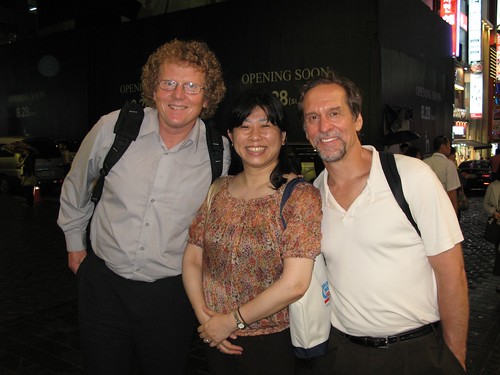
Brynjulf Stige, Kana Okazaki-Sakaue and Alan Turry.
Nancy Jackson, PhD, MT-BC, Associate Professor and The Director of the Music Therapy Program at Indiana University-Purdue University
Congress Experience Itself:
The XIII World Congress in Seoul, Korea was a beautifully organized, thoroughly enjoyable experience. The amount of work put into the pre-planning was evident, as the accommodations for the event were lovely. There was a great mix of professional and cultural events, and I believe everyone felt welcomed and “at home.” The hospitality of the hosting music therapy group, as well as the Korean people themselves, was outstanding.
Professional Highlights for Me:
What I look forward to most when attending international conferences is the opportunity to spend time with my international friends, and to meet new colleagues who will become friends. While electronic resources have made our access to each other’s work so much easier, it is the ability to be in person with my colleagues and friends, to have discussions face to face, and to share a meal or a cultural event with them that allows those professional relationships and our mutual understanding to grow stronger and deeper. I find that to be invaluable for my own thinking about my and others’ work, and for a deeper sense of connection to my professional family.
Personal Highlights for Me:
I was able to bring my teenage son with me to the Congress in Seoul. This was an experience that was better than I could have ever imagined. Because the Congress was so well organized, and because Seoul is such a visitor-friendly city, my son was able to have great fun and fabulous new experiences, even though he was “stuck” with mom at a professional conference. Not only was he able to learn from and enjoy all the cultural events and sightseeing, he was able to see his mom in a context that was completely new to him. We learned so much about each other through this experience, and our relationship has been permanently and positively changed by it. I look forward to bringing my other son to the next World Congress.
Kim: What was James's favorite part of the World Congress of MT in Seoul?
James: " That's a hard question. I really liked that event at the university where there were taiko drummers and the harmonica ensemble and the ribbons dancers. And I really liked the food. I liked all of the different people I met, and I loved seeing all of the palaces. That was really cool."
Kim: What was your (memorable) Korean food experience? I remember you were cooking Korean food at home after returning from Korea?
Every time we ate in a restaurant that we stumbled upon or that a local person recommended, it was a great experience. I already loved Korean food because of a previous trip to Seoul, so I was comfortable being adventurous and trying things I hadn't before. The great hospitality of the Korean people was especially evident at these times, as we sometimes went places where the folks at the restaurant spoken very little English, and yet they were so welcoming and so willing to try and communicate with us (all of whom could only say "hello" and "thank you" in Korean). I think my favorite experience was the first night that we were there, and a large group of us found a wonderful little barbecue way off the main drag. We clearly didn't know what we were doing, how to order, etc. I think we were the entertainment for everyone there that night. Even though they were laughing both at and with us, people were so friendly and wanted to try and talk with us. The food was just great, and the fellowship made all of us feel like we were in the best place in the whole city.

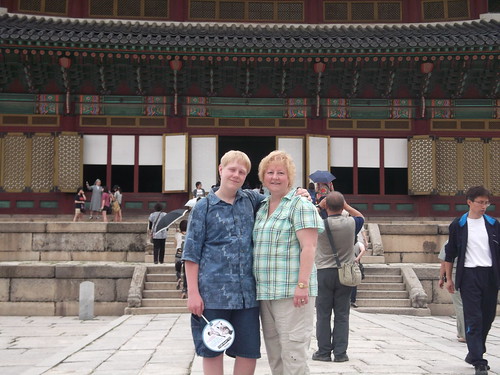

Group picture includes the following from L to R:
Jim Hiller,
Susan Gardstrom,
Megan Brewer,
Rose Fienman,
Debbie Bates,
Claudio Cominardi,
Larisa McHugh,
James Jackson,
Jin Lee
Joy and Allen
Sharon Gratto
Ayako Konishi, Associate Professor, Ogaki Women’s College, Japan
The 13th World Congress of music therapy in Korea was one of the best international conferences I experienced. It is only a one-hour flight to Seoul from Japan, so it was a great opportunity for myself and other music therapists in the Eastern Asia area to attend and exchange our knowledge. I traveled alone, but there was no problem taking the subway to the Sookmyung Women's University. I loved the Korean dance and drum performance that was held during the welcoming and closing ceremonies. I gave my poster presentation there, and had meaningful discussions with people. It is not easy for me to attend annual international conferences, but since I had such a wonderful experience in Seoul, I will be attending the World Congress of Music Therapy conferences more often.
Jana J. Skrien Koppula
In July of 2011, I got to do what I had been planning on doing for a very long time... I visited my birthplace.
Attending the 13th World Congress of Music Therapy in Seoul, South Korea was so much more to me than just an amazing opportunity to mingle with and learn from music therapists worldwide. My parents adopted me from South Korea when I was only 6 months old. I grew up in a small, rural town in southeastern Minnesota. I was blessed with an amazing family and parents who were always and still are supportive, caring and loving and always encourage me to do my very best in whatever I do. About 15 years ago, they offered to take our family to Korea to see where my sister (also adopted) and Iwere originally from. Due to college, weddings, children, jobs and various other events, this kept getting put on the back burner. Then, I learned that the 13th World Congress was going to be held in Seoul, South Korea. I knew I had been given a rare opportunity to combine a professional opportunity with a personal dream. I knew I had to go!
I convinced my college professor, Roberta Kagin, to come with me as a roommate and co-traveler. We were very excited to be surrounded by international music therapists and to have so many learning opportunities on our hands. We were thrilled at the chance to immerse ourselves in a very new culture—with its food, environment, and history—for a short amount of time and we knew the conference would have some amazing cultural showcases to add to the experience. Then, my parents and my sister decided they would come to Korea too, and, to my delight, our trip got lengthened.
I have some wonderful memories of the Congress: the music and drumming performances were outstanding, the children's choir that closed the Congress was moving – I don't think there was a dry eye in the house, listening to a room full of Korean music therapy students sing the blues was fantastic, getting to join the Temple University dinner as an honorary member and meet some amazing therapists was a blast and I met some fascinating music therapists from all over the world! However, the chance to visit the place of my birth and walk the streets, learn some history and see the sights meant more to me than anything else. We visited the DMZ and a Korean Folk Village, ate some amazing food, and took in the sights, smells, and sounds of Seoul. And what made it priceless was getting to experience this all with my family. I'm so grateful to the World Federation for choosing Seoul as a site for a World Congress – it was an experience I will never, ever forget. Thanks so much for this experience.
Roberta Kagin, PhD, Associate Professor and The Director of Music Therapy at Augsburg College
When I first thought about going to Korea for the World Congress, I was excited to think about the possibility of locating the Presbyterian Church my Great Uncle, Dr. Edwin Kagin, helped to begin in the early 1900s. However, all I had to go on to locate it was an old calling card.
My sister and I tried several different ways to locate the church, going through the National Headquarters of the Presbyterian Church and searches for Presbyterian missionaries, but to no avail. Then I contacted Seung-A Jung Kim, and in spite of all of her administrative duties planning for the conference, she spent time researching where he might have been. After the conference, she told me to come with her early on a Sunday morning, and we would be able to find the church. I was very skeptical, because we had so little to go on to locate the church. But she was determined.
Early on the Sunday morning after the conference, we set out. First on the subway, then into a bus for 2 hours, going through winding streets and to me, very foreign territory. I kept looking at the map, and was trying hard to imagine finding the church, but did still not believe it would be possible. Soon we came to a small town, and we got out of the bus and into a taxi, which drove us through narrow streets in the pouring rain. We finally came to the Cheongju Jeil Presbyterian Church, and Seung-A told me to come on in. Some Korean men met us with umbrellas and ushered us up a steep flight of steps. Seung-A wrote some words in Korean, and handed it to one of the women in the church. The woman smiled broadly, and took it to the Minister, who then read it, and everyone turned around and smiled and clapped for me. Apparently my Great Uncle was very well known as the Missionary who founded their church in 1907, and they were so grateful that we were there to worship. Thank you, Seung-A, for helping me to find this piece of history of my family.
Joreal Chen, Shandong Art University, China
July 4-5
As a special birthday present, I started my first overseas travel in July 4-9th to our neighboring country Korea thanks to the World Federation of Music Therapy and Sookmyung Women’s University. We had an international feast of Music Therapy and a great journey. After a 2 hour flight, I arrived in Seoul Incheon Airport; the departure city was Qingdao which is famous for the Tsingtao Beer of China. Qingdao and Seoul face each other across the sea, with similar climates but different speeds. Seoul’s traffic order is much better than Qingdao.

The building with its ethnic style in the picture is named Jin’s Guest House which is my lodging place these days. Jin’s guest house has a small balcony where you can relax, chat here with friends and enjoy the cool of summer night.
Opening session of the 13th World Federation of Music Therapy coordinated a Korean music cultural feast for our eyes. More than 600 music therapists from the entire world attended the 13th WCMT; more than 90 of them were from China. Meeting, and attending the workshops are two key points of these days. Another key point is friendship, MT meetings, create opportunity for a big party!
July 6
Meeting, go to the workshop are two key points of these days. Another key point is friendship, MT meeting, big party!
Chinese music therapy and Chinese daughter’s husband – Moreno
The drum in music therapy is very popular. Korean drums, long-drums are Korea’s most prominent musical instruments, and buks appear in the street too. Tempo, rhythm, and beat, not only belong to Africa, but also diffused by Asia. According to the Chinese calendar, today is June 6th. The sixth means everything goes well, so today is a great day because today is my birthday at the same time. More than 600 music therapists came a long way for the day, so we should do something to commemorate the special date. Look at the lower right corner of the following picture, the man who is climbing to the highest floor is our photographer; he must stand very high to be able to capture everyone.
July 7
After a big music party last night, rainy day comes! Prof. Gao Tian will give a speech today, his topic is something about MEDR using during the Wenchuan earthquake in the summer of 2008. The sudden earthquake built up China’s psychological crisis intervention system, include music therapy. Report of music therapy after an earthquake caused the attention of the world music therapists.
A GIM workshop this afternoon led by Hong Kong therapist Weiwen WU: Chinese folk music The Butterfly Lovers, I drew a picture named Childhood.
July 8
In 1995, in Hamburg Germany, a Chinese delegation attended the WCMT for the first time, with approximately 20 members. But today, 98 music therapists attended at the 13th WCMT. The Chinese have been trying to understand the world, with the hope that the world would be interested in the music therapy practice of China.
HaeSun Kim, MA, MT-BC, Music Therapist, Korea
Hello, my name is Hae Sun Kim, MT-BC and I am a graduate student at Colorado State University. In 2011, I was fortunate enough to get the opportunity to take part in the 13th World Congress of Music Therapy in Seoul, Korea, where I come from. Mainly, I was interested in connecting with music therapists and clinicians from around the world and learning about their cultural contexts, approaches, and ideas. I was able to learn a lot about the differences and commonalities from global music therapy professionals. It was my great honor to receive the first WFMT World Congress scholarship for students, along with five other music therapist students around the world.
Also, this congress was special to me because I was born in Korea, but I moved to and have received all my music therapy education in the United States. As an international student, I have always been interested in sharing my experiences and providing advice to prospective students who want to study abroad. Therefore, I did a presentation of my research on music therapy in Asia and studying abroad in the United States. In addition to my personal sharing, the congress was also filled with a variety of paper presentations, workshops, and spotlight sessions featuring the most respected researchers and students in music therapy around the world.
In 2010, I was so thrilled to find out that the World Congress of Music Therapy would be held in my hometown, Seoul, Korea. I was born in Korea, but moved to and have earned both my bachelor’s and master’s degree in music therapy in the United States.
From the congress, I have two personal memories among many wonderful memories and impressions: the scholarship and my first presentation. It was my great honor to receive the first World Federation of Music Therapy World Congress Scholarship for Student Award alongside five other music therapy students around the world. The scholarship was offered to undergraduate and graduate music therapy students and interns around the world.
Also, I presented my senior research project on “Music Therapy in Asia & Issues and Challenges for International Students in the United States.” At the presentation, I presented the history of music therapy in Asian countries including China, Japan, and Korea. I also shared my experiences and challenges that I had to face living in the United States as an international student with other prospective students who wanted to further their education in the States. My experience during the congress was truly unforgettable and impressive, and I look forward to attending the next 14th World Congress in Vienna, Austria.


